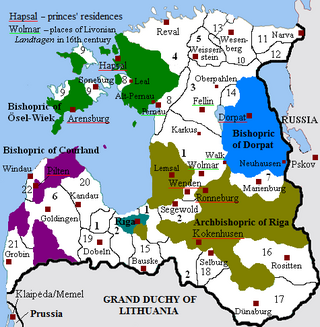
Livonia or in earlier records Livland, is a historical region on the eastern shores of the Baltic Sea. It is named after the Livonians, who lived on the shores of present-day Latvia.
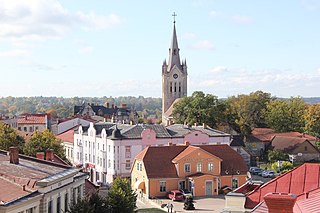
Cēsis, is a town in Latvia located in the northern part of the Central Vidzeme Upland. Cēsis is on the Gauja River valley, and is built on a series of ridges above the river, overlooking the woods below. Cēsis was selected to be one of the candidate cities for the title of the European Capital of Culture 2014.

Narva is a municipality and city in Estonia. It is located in the Ida-Viru County, at the eastern extreme point of Estonia, on the west bank of the Narva river which forms the Estonia–Russia international border. With 53,626 inhabitants Narva is Estonia's third largest city after capital Tallinn and Tartu.

The Livonian Order was an autonomous branch of the Teutonic Order, formed in 1237. From 1435 to 1561 it was a member of the Livonian Confederation.
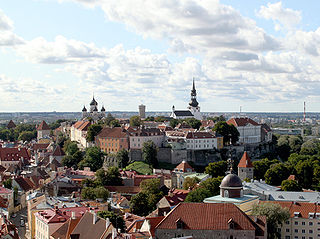
Toompea is a limestone hill in the central part of the city of Tallinn, the capital of Estonia. The hill is an oblong tableland, which measures about 400 by 250 metres, has an area of 7 hectares and is about 20–30 metres higher than the surrounding areas. In folklore the hill is known as the tumulus mound over the grave of Kalev, erected in his memory by his grieving wife.

Saare County is one of 15 counties of Estonia. It consists of Saaremaa, the largest island of Estonia, and several smaller islands near it, most notably Muhu, Ruhnu, Abruka and Vilsandi. The county borders Lääne County to the east, Hiiu County to the north, and Latvia to the south. In 2022, Saare County had a population of 31,292, which was 2.4% of the population of Estonia.

The Narva, formerly also Narwa or Narova, flows 77 kilometres (48 mi) north into the Baltic Sea and is the largest Estonian river by discharge. A similar length of land far to the south, together with it and a much longer intermediate lake, Lake Peipus, all together nowadays form the international border between Estonia and Russia.

Rakvere is a town in northern Estonia and the administrative centre of Lääne-Viru County, 20 km south of the Gulf of Finland of the Baltic Sea. From the 13th century until the early 20th century, Rakvere was more widely known by its historical German name, Wesenberg(h).
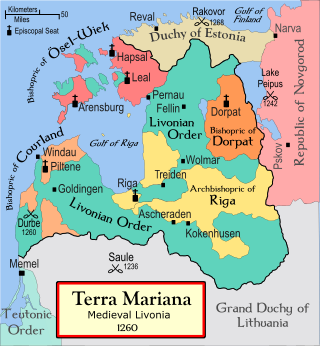
Saint George's Night Uprising in 1343–1345 was an unsuccessful attempt by the indigenous Estonian population in the Duchy of Estonia, the Bishopric of Ösel-Wiek, and the insular territories of the State of the Teutonic Order to rid themselves of Danish and German rulers and landlords who had conquered the country in the 13th century during the Livonian Crusade; and to eradicate the non-indigenous Christian religion. After initial success the revolt was ended by the invasion of the Teutonic Order. In 1346, the Duchy of Estonia was sold for 19,000 Köln marks by the King of Denmark to the Teutonic Order. The shift of sovereignty from Denmark to the State of the Teutonic Order took place on November 1, 1346.

Ivangorod Fortress is a castle in Ivangorod, Leningrad Oblast, Russia. It was built in the 15th century. It is located on the east bank of the Narva River, which currently forms the international border between Russia and Estonia, across from the city of Narva in Estonia.

The Gothic architecture arrived in Poland in the first half of the 13th century with the arrival of the Dominican and Franciscan orders. The first elements of the new style are evident in the foundation of the Dominican Trinity church in Kraków (1226–1250), built by Bishop Iwo Odrowąż. Rebuilding of the Wrocław Cathedral, started in 1244, was another early manifestation of the Gothic style. The earliest building in Poland built entirely in the Gothic style is the chapel of St. Hedwig in Trzebnica (1268–1269), on the grounds of a Cistercian monastery.

Toompea castle is a medieval castle on Toompea hill in the central part of Tallinn, the capital of Estonia. In modern times, it houses the Parliament of Estonia.
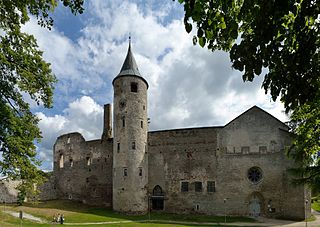
Haapsalu Castle is a castle with cathedral in Haapsalu, Estonia, founded in the thirteenth century as the seat of the Bishopric of Ösel-Wiek. According to legend, during full moons in August, an image of a maiden, The White Lady, appears on the inner wall of the chapel.

Bauska Castle is a complex consisting of the ruins of an earlier castle and a later palace on the outskirts of the Latvian city of Bauska.

The Livonian crusade consists of the various military Christianisation campaigns in medieval Livonia – modern Latvia and Estonia – during the Papal-sanctioned Northern Crusades in the 12th–13th century. The Livonian crusade was conducted mostly by the Holy Roman Empire and the Kingdom of Denmark. It ended with the creation of Terra Mariana and the Danish duchy of Estonia. The lands on the eastern shores of the Baltic Sea were one of the last parts of Europe to be Christianised. The available information is largely based on Livonian Chronicle of Henry.
This article covers the architecture of Estonia.

Sigulda Medieval Castle ruins are located on the edge of the Gauja valley in Latvia. The original castle was built in 1207 as a castellum type fortress, later rebuilt into a convent type building. The residence of the Land Marshal of the Livonian Order since 1432.
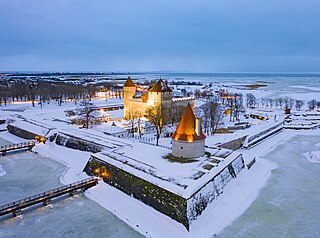
Kuressaare Castle, also Kuressaare Episcopal Castle, is a castle in Kuressaare on Saaremaa island, in western Estonia.

Terra Mariana was the formal name for Medieval Livonia or Old Livonia. It was formed in the aftermath of the Livonian Crusade, and its territories were composed of present-day Estonia and Latvia. It was established on 2 February 1207, as a principality of the Holy Roman Empire, and lost this status in 1215 when Pope Innocent III proclaimed it as directly subject to the Holy See.






















